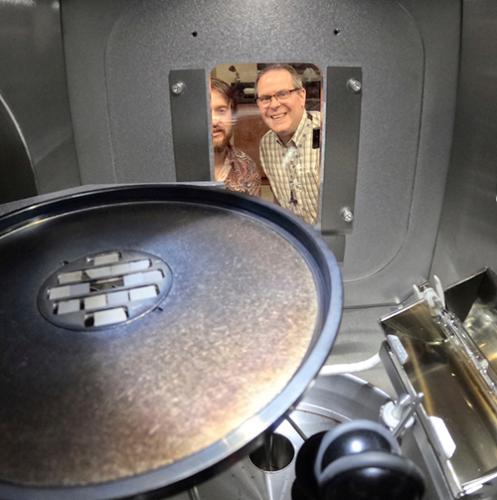
Andre Juliao, left, a doctoral student, and Lance Cooley, a professor of mechanical engineering at the FAMU-FSU College of Engineering and director of the Applied Superconductivity Center. (M Wallheisier/FAMU-FSU College of Engineering)
To hear an axion, you have to be listening very, very carefully.
These hypothetical elementary particles may be responsible for some or all dark matter in the universe, so there is strong support in the physics community to find one, but it’s not easy because their energy inputs are so minuscule.
Researchers at the FAMU-FSU College of Engineering are working with scientists from the Axion Dark Matter Experiment (ADMX) team at Lawrence Livermore National Laboratory (LLNL) on a U.S. Department of Energy project to develop particle detectors that are sensitive enough to find these particles. The research, funded by a $350,000 grant, is part of a greater effort by the Department of Energy to explore the development of superconducting quantum detectors.

“Theoretically, an axion passing through a magnetic field can decay into a photon, in the energy range where microwaves are,” said Lance Cooley, a mechanical engineering professor at the FAMU-FSU College of Engineering and director of Florida State University’s Applied Superconductivity Center. “ADMX uses microwave resonators to catch any photons emitted by axions by listening for their signal, which should allow us to detect these particles and verify their existence.”
Scientists use specialized equipment known as a haloscope to search for evidence of the particles. Cooley, the principal investigator for the project, is working with the ADMX team to develop prototype cavities for axion haloscope microwave detectors.
The ADMX haloscope consists of a large-diameter solenoid magnet with a copper-plated, frequency-tunable microwave cavity at the center. The microwave cavity is a type of acoustic resonator that can look for axions at different frequencies.
“So far, the search for axions has been unsuccessful, because if they exist, they are evidently ringing too softly to notice,” Cooley said. “Some theories suggest that the resistance of copper in the instrument is just not low enough to catch the axion whispers.”
So how can researchers crank up the sound? By using superconductors, the researchers think they can take advantage of zero resistance or low resistance in microwave conditions. The FSU experiment will target and improve the quality of the resonant tone in superconducting microwave cavities.
“A wind chime is an example of an acoustic resonator; the appearance of an axion would be analogous to hearing a wind chime spontaneously ring,” Cooley said. “The challenge, however, is there can be multiple resonances and coupling tones, and we really want to target the primary tone and then listen for an abrupt uptick in volume.”
Cooley’s group is using the chemical compound niobium-tin, or Nb3Sn, to develop prototype cavities. The material retains its superconductivity in the high magnetic fields of a haloscope. Better sensitivity requires the development of superconducting coatings on conductive copper resonators, a nascent technology for the 2 to 10-gigahertz frequency range.
“Many of the materials used in the cavity of the haloscope are brittle, so forming the precise cavity shape becomes quite challenging,” Cooley said. “Our grant aims to make Nb3Sn superconducting coatings inside a cavity about the size of a coffee mug.”
The researchers established methods for making large-area coatings of Nb3Sn in past work and are now scaling to larger shapes and pieces. Nb3Sn is capable of higher fields than the current niobium-titanium alloy conductors used in MRI magnets, so the idea is to use a large MRI magnet with resonators inside to detect axions, Cooley said. The proposed work aims to validate scalable and cost-effective techniques for applying high-quality Nb3Sn superconducting coatings by mid-2025.
The work is funded by the High Energy Physics (HEP) program in the U.S. Department of Energy.
The mission of the HEP program is to understand how our universe works at its most fundamental level. It will inform HEP about the potential of future cavity development work in one or more dark-matter initiatives and may result in the continuation of work as a longer-term university research grant aimed at fundamental materials challenges for superconducting detectors.
RELATED ARTICLES
Scientist succeeds his mentor as director of MagLab's Applied Superconductivity Center
